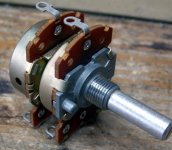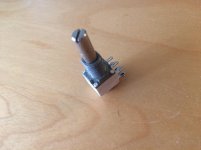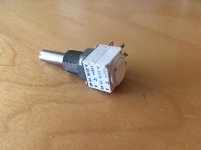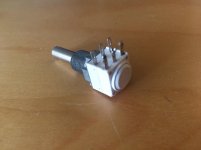Hi there,
I have an old Cello Palette Preamp and the main level pot has a weird lull/jump at 5 (12 o'clock) - right around that point one channel drops out slightly and the at 6 (1 o'clock) the volume jumps MUCH louder. There is no crackling so I'm not sure it would be a dirty pot. I've only ever changed out an alps blue 100k pot before, but this one I'm not familiar with. Its a 50k 10% but small white box shape and appears it might be even soldered down to the board beneath. Any help appreciated!
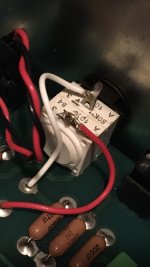
I have an old Cello Palette Preamp and the main level pot has a weird lull/jump at 5 (12 o'clock) - right around that point one channel drops out slightly and the at 6 (1 o'clock) the volume jumps MUCH louder. There is no crackling so I'm not sure it would be a dirty pot. I've only ever changed out an alps blue 100k pot before, but this one I'm not familiar with. Its a 50k 10% but small white box shape and appears it might be even soldered down to the board beneath. Any help appreciated!

OK I think its Vishay surface mount but not seeing one that has connections on top like this. Flipping over this board to see how many pins go through.
Looks like a Vishay P11 option J (see page 13 in the data sheet linked):
https://www.vishay.com/docs/51031/p11sp11a.pdf
https://www.vishay.com/docs/51031/p11sp11a.pdf
Definitely a Vishay / Sfernice pot, and I would guess that the top terminal is some sort of loudness tap.
I'm surprised it's bad. Those pots are extremely high-quality (and seriously expensive). I consider those to be among the best small form factor pots on the market. Mouser carries some, and I know AML (audio maintenance limited) carries some as well. In all likelihood though, it's a custom part.
You could try contacting State electronics. They tend to handle all of the custom modular potentiometer tasks and have for a really long time. You'll pay, but they might have an option.
What's the shaft size and pin spacing?
I'm surprised it's bad. Those pots are extremely high-quality (and seriously expensive). I consider those to be among the best small form factor pots on the market. Mouser carries some, and I know AML (audio maintenance limited) carries some as well. In all likelihood though, it's a custom part.
You could try contacting State electronics. They tend to handle all of the custom modular potentiometer tasks and have for a really long time. You'll pay, but they might have an option.
What's the shaft size and pin spacing?
Maybe the source of the problem is not the pot as mentioned earlier. It could be the signal offered on the taps. Check if this is not out of phase or worse...
I would scope the pot as you turn it and see if the signal jumps.
Could be a coupling capacitor gone somewhere and upsetting DC conditions.
Could be a coupling capacitor gone somewhere and upsetting DC conditions.
Okay, looking at the price / value of this piece of equipment, the cost of a custom pot from State maybe isn't as big an issue as I thought. That would probably be my next course of action if I were the OP.
Right, thank you for all the input!
I'm always a bit out of my depth here, but I do have a hunch its not the pot, just figured I might try to replace that first see if it fixed the problem, but yes its not your typical oxidization issue. When the pot is about half way turned there is a a discrepancy between channels for a very small portion of the turn and then it jumps in volume significantly. Only and always in the same position, its not intermittent.
I don't own a scope unfortunately, but I do know the local service on Cello gear is quite pricey so hoped to DIY if I could. Figured changing out the pot was the first step before losing more money and listening time putting it in the shop.
That Vishay looks close but correct its missing the tap. I haver to do quite a lot of disassembly to get it removed and check the pin spacing, but the shaft measures 6mm.
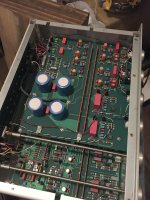
Pot is top right corner, but I will have to disassemble 4 more to flip the board.
I'm always a bit out of my depth here, but I do have a hunch its not the pot, just figured I might try to replace that first see if it fixed the problem, but yes its not your typical oxidization issue. When the pot is about half way turned there is a a discrepancy between channels for a very small portion of the turn and then it jumps in volume significantly. Only and always in the same position, its not intermittent.
I don't own a scope unfortunately, but I do know the local service on Cello gear is quite pricey so hoped to DIY if I could. Figured changing out the pot was the first step before losing more money and listening time putting it in the shop.
That Vishay looks close but correct its missing the tap. I haver to do quite a lot of disassembly to get it removed and check the pin spacing, but the shaft measures 6mm.

Pot is top right corner, but I will have to disassemble 4 more to flip the board.
Last edited:
Before removing please measure ! It could safe a lot of work and frustrations if the pot is not defective after all.
Well I truly screwed this up. The shaft of the pot separated from the rest very easily and after getting it back together the levels jump all over. I somehow misaligned the wiper and now it's all out of wack, and getting under the board to measure the terminals was not easy.
If anyone knows someone in LA that works on Cello other than Meyer, let me know!
If anyone knows someone in LA that works on Cello other than Meyer, let me know!
Is there any printed part numbers on the potentiometer? It is the output level contol, so it should have an audio log taper. I am not sure why it has a centre tap; posibly to 'calibrate' the level matching of the control at mid point.
With a good quality Alps potentiometer or stepped attenuator replacement you could dispense with the tap. All you need to know is what the total resistance of the potentiometer is. I would guess something around 50kΩ.
With a good quality Alps potentiometer or stepped attenuator replacement you could dispense with the tap. All you need to know is what the total resistance of the potentiometer is. I would guess something around 50kΩ.
No part numbers that I can see no. The links to data sheet earlier in the thread is the closest I've found, but its only got 1 tap (this has 2, right?) and I can only find 10k and 100k, not 50k. I've just emailed Vishay to see if they can help as well. I grabbed an Alps actually, as I was going to just replace and I was told on good authority that was the pot used but its too big to sit on the board and the shaft to align with the hole. Argh!
A bourns unit might fit. Have a look at this data sheet:
https://au.mouser.com/datasheet/2/54/PTR90-777814.pdf
https://au.mouser.com/datasheet/2/54/PTR90-777814.pdf
The only thing I'm not really sure about it: this preamp has a 5 band EQ with an in/out switch and there are L/R pots that mix the EQ with the signal - is it possible the taps on the main volume pot are related to that? I can't find a schematic to save my life.
A bourns unit might fit. Have a look at this data sheet:
https://au.mouser.com/datasheet/2/54/PTR90-777814.pdf
I did see that one too.
Will grab this and see if it works: https://www.mouser.com/ProductDetail/Vishay-Sfernice/P11A2C0BJSZ00503KA?qs=LCMWAU1DZcynEsLDOqYp1w==
Last edited:
My answer from a position of ignorance, but with a high degree of certainty is... no. I can't see what purpose that would have.is it possible the taps on the main volume pot are related to that?
The pot you linked has a linear curve. That would mean you are almost at maximum volume by 9 or 10 o'clock. You need an audio or logarithmic taper, which will be -20dB at 12 o'clock, not the -6dB of a linear potentiometer.
Have you attempted to trace the circuit?

The control is most likely in a simple circuit like this picture, times 2 for stereo. The input will come from a driver transistor or op amp, the output will go to another amplifier stage. R is the load impedance of the next stage. In and out may be capacitor coupled to block DC which causes scratchy noise when the wiper is moved.
If there is a tap on the pot, it would be somewhere in the middle (near the wiper in the picture) and will go off to some circuitry. A loudness circuit would have a switch to enable / disable and then a capacitor... I was thinking that somehow there is a -20dB amp connected at the tap, so that in the middle of its range the control has both channels exactly balanced in level. If this is the case the tap can be dispensed with. but that's just a guess on my part I haven't seen a circuit implemented like that.
Last edited:
Damn! I checked with Vishay and...
This PN is a proprietary design.
We cannot sell this part without LOA from CELLO manufacturer
- Home
- Source & Line
- Analog Line Level
- Help me ID this potentiometer?
